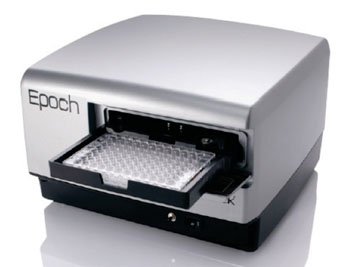Dominant Gene Mutation Causes Incurable Eye Disorder
By LabMedica International staff writers
Posted on 03 Feb 2015
Retinitis pigmentosa damages the retina and its early symptoms include decreased night vision and peripheral vision and once it starts, the loss of vision is relentlessly progressive, often ending in blindness.Posted on 03 Feb 2015
Retinitis pigmentosa (RP) is exceptionally heterogeneous with many different genes implicated, many different disease-causing mutations in each gene, and varying clinical presentations even among members of the same family.

Image: The Epoch microplate spectrophotometer (Photo courtesy of Biotek).
A team of scientists led by those at the University of Texas Health Science Center (Houston, TX, USA) carried out exhaustive hereditary analysis of a large family with vision issues, and has uncovered a new gene tied to an incurable eye disorder called retinitis pigmentosa. The patient cohort contains 265 families with a high likelihood of autosomal dominant inheritance. One affected individual from each family has been tested previously for mutations in the currently known autosomal dominant RP (ad RP) genes.
Genomic DNAs from nine affected, six unaffected at-risk, and one unaffected member of the affected family were genotyped with an ABI High Density 5cM 100 STR marker set (Life Technologies; Grand Island, NY, USA). Exome sequencing and the hexokinase 1 (HK1) exome variant was typed by amplification and fluorescent di-deoxy sequencing with polymerase chain reaction (PCR) primers. The team also performed a Glucose 6 Phosphate (G6P) assay in affected individuals and colorimetric measurements were made using optical density (OD) 450 nm measurements on an Epoch microplate spectrophotometer (BioTek; Winooski, VT, USA).
Exome sequencing in the affected family led to identification of a single, novel coding variant33 (c.2539G>A, p.Glu847Lys) in the hexokinase 1 gene (HK1) present in all affected individuals and absent from normal controls. One affected family member carries two copies of the mutation and has an unusually severe form of disease, consistent with homozygosity for this mutation. Screening of additional adRP probands identified four other families (American, Canadian, and Sicilian) with the same mutation and a similar range of phenotypes. The families share a rare 450 kilobase haplotype containing the mutation, suggesting a founder mutation among otherwise unrelated families.
Stephen P. Daiger, PhD, the senior author of the study, said, “The story of the HK1 mutation is itself interesting. What we found is a mutation present in families from Louisiana, Canada, and Sicily. Our evidence suggests the mutation arose in a common ancestor who lived centuries ago. The mutation spread in Europe and North America, and may be common among Acadians in Louisiana. This is called a founder mutation.” The team hypothesized that the effect of this mutation is limited to the retina, as no systemic abnormalities in glycolysis were detected. The study was first published on September 4, 2014, in the journal Ophthalmology & Visual Science.
Related Links:
University of Texas Health Science Center
Life Technologies
BioTek













